Synopsis:
This article describes how the Creative Science Foundation came into being. It will explain how two threads of work, one at Intel labs (which used science-fiction for product innovation), the other at Essex University (which used science fiction for public communication & student motivation) collaborated on a series of public events that led to forming Creative Science Foundation. a non-profit organization set up to research, support and promote the application of methods that encourage creative thought processes as part of supporting science, engineering, business and sociopolitical innovation. It will also describe some of the early adopters who have played key roles in developing the foundation.
.
Connecting With Dreams: Robot Inspirations
The roots of the Creative Science Foundation (CSf) can be traced back to the eighties when Essex University set up a robotics lab (The Brooker Lab) as a means to motivate students in their studies of computer science. The rationale underpinning this was that many science and engineering faculty were drawn into science and engineering careers by reading science fiction and dreaming of building robots, time machines and the like, so they felt many students would have had similar experiences or, even if they hadn’t, would find the idea of building intelligent robots inspiring! In addition many computer scientists were inspired by object-oriented design, especially the aspects of object orientation that mirrored living entities (us) which provides an example of one of the most successful complex systems known; the earth (and our mega-cities, societies and complex personal relationships)! These thoughts inspired computer science faculty at Essex to propose and build a mobile robotics lab in Essex University based on object-oriented principles (see the “History of Essex Robots”). Robotics proved to be a fantastic tool for teaching and researching computer science because it embraces the full gamut of core computing topics including hardware, sensing, actuators, operating systems, programming, networks, vision and, of course, Artificial Intelligence (AI). The robotics theme also proved to be a brilliant motivator, connecting with the student’s dreams and aspirations and fostering a love of research and creative thinking all of which would lay an important foundation for the later development of science-fiction prototyping.
Science Fiction and Fact: An inspiring Marriage
At the time the Essex University robotics laboratory was built, there was a very popular SciFi comedy called ‘The Hitchhikers Guide to The Galaxy’ being aired on the BBC (both as a radio and TV series). The story, written by the UK author Douglas Adams, featured a depressed (and incurably pessimistic) robot call Marvin, who contemplated its own existence, seeing its life as being doomed to a secondary and subservient role to people. Although ‘machine depression’ was used a vehicle for comedy in Adam’s books it motivated a marriage between New AI and psycho-analysis that was pioneered at Essex via the accidental good fortune of the Essex research group having a theoretical psycho-analyst, Dr Graham Clarke as a member, which opened up fantastic opportunities to explore new ideas for AI based on higher level theories of the mind. Some of these ideas, such as multiple personas’ found strong resonances with ‘New AI’ models of intelligence. As a consequence, the Essex team became especially interested in notions of nebulous mechanisms within the mind, such as “the self”, wondering what that was and how it might affect robot design. To create a ‘self’ the Essex team devised a variation of a behaviour-based architecture in which the decisions made by the robot were not only dependent on the real-time sensory data derived from the physical world, but were also driven from a personal and weighted temporal history of all sensory-action pairs in the form of a hidden ‘experience layer’ which, depending on its intensity, had the ability to override (or at least, substantially influence) the robots actions. This was a separate and computationally smaller process to more regular reasoners and planners used in regular AI and was very much aimed at exploring the notion of ‘self’ and how there are apparent beneficial collisions between rational and irrational behaviours. An example of an early paper that discussed this was “Using Multiple Personas in Service Robots to Improve Exploration Strategies When Mapping New Environments”. Of course all our science was wrapped in much more recognizable science contributions such as fuzzy logic (a specialty we continue to lead on – we were the first group to apply Type-2 Fuzzy logic to robotics and AI).
Facts Can Be Stranger Than Fiction
All this would in itself have been a reasonable motivation for exploring the nebulous side of AI but then a rather sad incident occurred that motivated it further. An ex Essex PhD students who had researched robotics at Essex, Dr Simon Egerton (publishing a dissertation in 2003 called “From Mammals to Machines: Towards a Biologically Inspired Spatial Integration System for Autonomous Mobile Robots“), had a Malaysian girlfriend who returned home around 2005. Simon decided to quit his UK friends and a good job for love of his Malaysian girlfriend and headed off with just a few pounds in his pocket and a big heart to live in Kuala Lumpur with her. Sadly, things didn’t work out for Simon and his Malaysian sweetheart and, as a result, one winter’s day, Simon and his ex-PhD supervisor …. me …. Vic Callaghan) ended up in the Costa Café in Culver Square, Colchester, discussing the logic of love and women, and finding ourselves stumped by both!
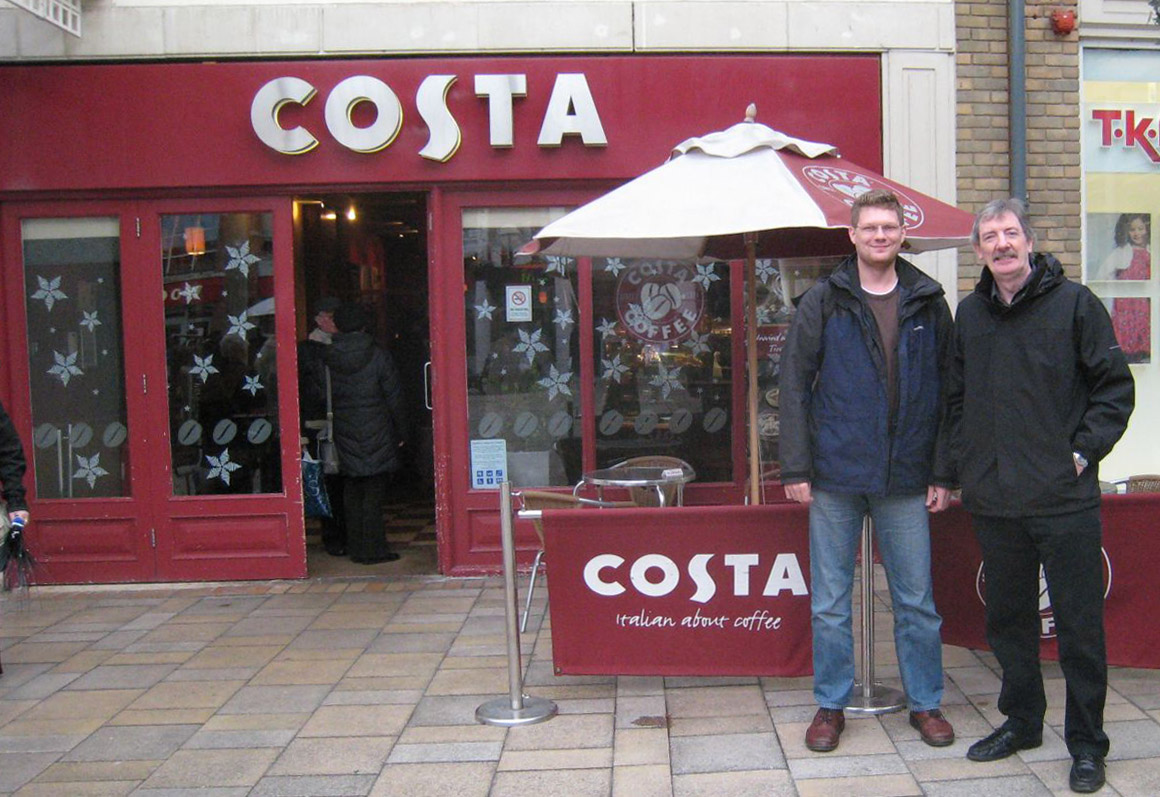
We figured out that love (and many other emotions) can be entirely illogical, and defy the kind of reasoning that scientists and engineers seek to bring to bear on the issue. Even more puzzling, why had the result of such a powerful design and adaption mechanism – evolution – running for hundreds of thousands of years – resulted in creating a seemingly irrational, illogical and entirely frustrating mechanisms such as emotions and love? What exactly was love, and how did it improve the performance and survival of people? If nature had deemed such irrational mechanisms to be so important in people, was science missing something by not including them in robots? But what were those seeming irrational mechanisms that could override people’s logic; at that point it seemed love and other emotions were beyond logic and, in scientific terms, were somewhat Nebulous! So, after that discussion we consulted our friendly psycho-analyst, Graham Clarke and started to investigate this further which resulted in our first paper and discussion on this “Using Multiple Personas in Service Robots to Improve Exploration Strategies When Mapping New Environments” (presentation), presented at the 4th International Conference on Intelligent Environments, Seattle, 21 – 22 July 2008, followed by “Instability and Irrationality: Destructive and Constructive Services within Intelligent Environments“ presented at the 5th International Conference on Intelligent Environments, Barcelona, Spain, 20-21 July, 2009, “Quantum Computing: Non-deterministic controllers for Artificial Intelligent Agents“ presented at the 5th International Workshop on Artificial Intelligence Techniques for Ambient Intelligence (AITAmI’10), Kuala Lumpur, Malaysia. 19th of July 2010 and, finally, “Jimmy: Searching for Free-Will”, Creative Science 2011, Nottingham, 26th July 2011. The main contribution of this work was not really the science (our best science papers and work are presented elsewhere) but rather that it spawned a new imaginative way of engaging with society in discussions about research and the sort of world people want. From a personal viewpoint (back to the debate on logic versus emotions) it can be seen that the Creative-Science Foundation was, in one sense, started by a man (Simon) being spurned by a woman (or at least by men trying to understand women!). As they say, the truth can sometime be stranger than fiction – but that was the beginnings of Creative Science and “Nebulous Mechanisms; The Dr. Simon Egerton Stories” (the latter written by Brian David Johnson, Intel’s Futurist).
Communication: Everyone Can Understand a Story
In what seemed like an unrelated activity (at the time!) there was a UK TSB-EPSRC funded research project running at Essex University called “Pervasive Home Environment Networking (PHEN)” which concerned installing networked sensing technologies in domestic homes. At a meeting in Loughborough University (one of the project partners), there was a discussion about the merits of storing sensed data from homes on a centralized company-owned server, that split opinion, with some strong arguments against this which, in turn, led Essex making a presentation to the the United Nations Habitat, World Urban Forum on 13-17 September 2004 in Barcelona, Spain (in meeting called “Cities: Crossroads of Cultures, Inclusiveness and Integration” organised under the IRFD Theme: “The Role of Cities in an Information Age”). The presentation was an attempt to make governments and people aware of the risks that emerging technologies (eg pervasive and ubiquitous computing, Internet-of-Things & Intelligent Environments etc) posed for citizen’s and government’s privacy, advocating the need for international regulation to prevent abuse. At the time, such technologies were in an ascendancy, so this was a difficult message to convey to a market enthusiastically adopting such technology; plus the technologies and societal issues were complex and not easily understood by decision makers. By way of a solution, the Essex group came up with the concept of writing a set of short vignettes (in the form of science-fiction stories) to communicate the ideas to the assembled UN delegates (who were mostly non-technologists). The short science-fiction vignettes proved to so effective in communicating science concepts to the assembled audience that this communication technique became a key aspect of the later (and more formalized) SF-Prototyping methodology. In addition to presenting in-person at the UN meeting, Essex wrote a paper, “Pervasive Computing and Urban Development – Issues for the individual and society“ (presentation, description and report of the event) which provides both an interesting insight into early SF-Prototyping and, somewhat ironically, prophesied problems that were to emerge 9 years later, in 2013, with the privacy issues raised by controversy surrounding data gathering at the NSA (ie the Edward Snowden affair). Although these issues would seem worthy of debate now, at the time they were seen differently (a mixture of indifference and fear of “upsetting the ‘commercial’ applecart”) delaying formal publication of the paper in the mainstream media until some 5 years later (in 2009), and then in a somewhat sanitized form that you can read in “Some Socio-Technical Aspects Of Intelligent Buildings and Pervasive Computing Research“. In terms of the history of Creative Science, this paper was significant as it used short science-fiction stories (scenarios) to illustrate societal consequences for technological developments. It seems every loves a story, and that everyone can understand a story, connecting specialists and non-specialists in a jargon- and qualification- free debate, making it the perfect vehicle for stimulating society-wide conversations aimed at building a better future, an aspect that is a key feature of Science Fiction Prototyping.
Innovation: The Lifeblood of Companies
In a parallel world, Intel Labs in Portland (USA), Brian David Johnson was pondering the question that haunts all companies, how to lead innovation rather than become a victim of it. The particular challenge that Intel faced was that their products (integrated circuits) take at 7-10 years to develop, which is a long time in technology (eg 4-5 generations of mobile phone). Scenario based design, which is frequently employed as part of the product development cycle, has strong resonances with story writing. Given Brian was as an accomplished Science-fiction writer (see “Fake Plastic Love“) its not surprising to see he spotted the potential for much richer, and more forward looking scenarios, SF-Prototype to be integrated into an expanded version of Intel’s Consumer Experience Architecture (CEA), a product design framework and marking the beginning of the Science Fiction Prototyping methodology.
Beer: The Elixir of Innovation?
Perhaps, Science Fiction Prototyping would have remained an internal Intel tool, had it not been for a a few glasses of weißbier (white beer) enjoyed by Brian Johnson, Michael Gardner and myself in a tavern in the beautiful old German town of Ulm. All three of us had been attending the IE’07 conference where Brian was an invited speaker, giving a presentation called “Do Digital Homes Dream of Electric Families?” – Architecting Consumer Experience“. After his talk we found a bar that stayed open after midnight and struck up a conversation that covered many areas, including the nature of reality, before settling on a discussion about our shared belief that science fiction had the power to engage people in conversation about the future and drive innovation towards that future. After this we exchanged papers sending Brian our “Some Socio-Technical Aspects Of Intelligent Buildings and Pervasive Computing Research“ which had used vignettes as a means of communicating science ideas to UN attendees, combining it with Brian’s expanded “Expanded Consumer Experience Architecture Framework” to become the SF-Prototyping approach. Then in 2008 when the IE’08 conference moved to Seattle we met up again and discussed how SF-Prototyping might be moved forward and came up with the idea to organize a set of workshops, the first being CS’10 in Kuala Lumpur and the second CS’11 in Nottingham (see the Creative-Science website for more details). Among the many outcomes of the IE’08 conference meeting was the formation of the The Creative-Science Foundation as a vehicle to promote and support the wider adoption of SF-Prototyping ideas.
Following its formation, the Creative Science Foundation has participated in the organisation of numerous conferences, workshops, journals and books which are listed on the CSf ‘Activities’ web page. Of course, we have not forgotten the innovative quantities of German of weißbier (which we highly recommend!) and wherever possible try to use this product innovation methodology, as the following picture will testify (Brian & Vic about to enter an interestingly named UK Pub!).
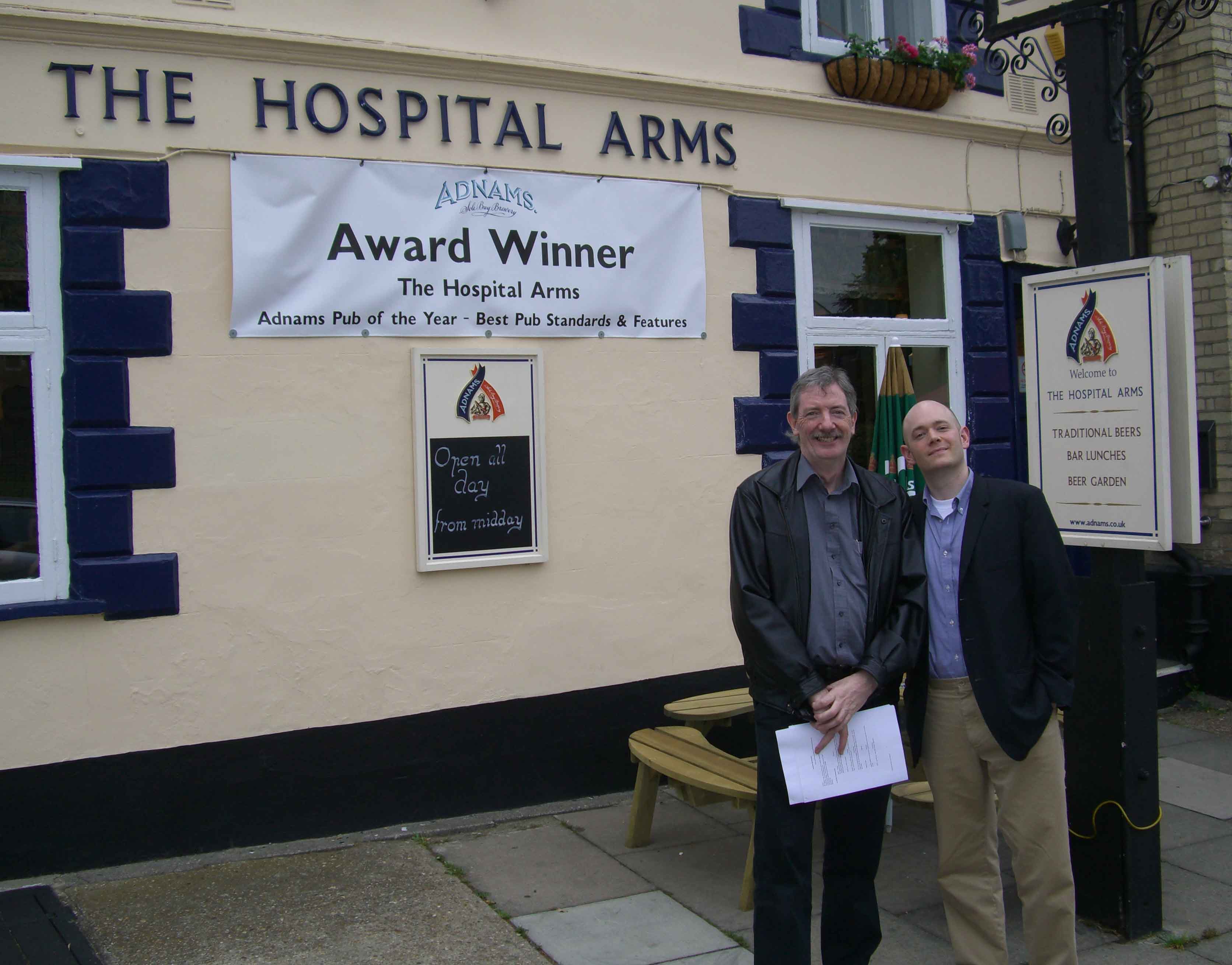
Collective Intelligence: The Power of The Crowd
Another notable direction can be attributed to Hsuan-Yi WU who, in 2010 undertook a 3 month placement to work at Essex University with Vic Callaghan on a business plan for the Essex Living Lab facilities. Through this partnership Wu became interested in Science Fiction Prototyping, reviewing Johnson’s book, writing the ‘Spiritual Machine‘ with Callaghan and, after returning home to the National Taiwan University, developed the ‘The Evolutionary Model of SFP‘ and a supporting ‘Imagination Workshop‘ Innovation-Lab methodology. The Imagination Workshop methodology has now become one of the principal innovation process used for SFP sessions.

The next notable point was on 4th February 2015 when Tiina Kymäläinen was awarded a PhD from Aalto University School of Arts, Design and Architecture for a The PhD, entitled ‘Science Fiction Prototypes as Design Outcome of Research’ and thereby becoming the first person to be awarded a PhD that grew out of Science Fiction Prototyping. Tiina’s thesis discusses how experience design findings from emerging technology research were used to construct design artifacts in the form of future-oriented science fiction short stories (Science-Fiction Prototypes). For more information click this link.
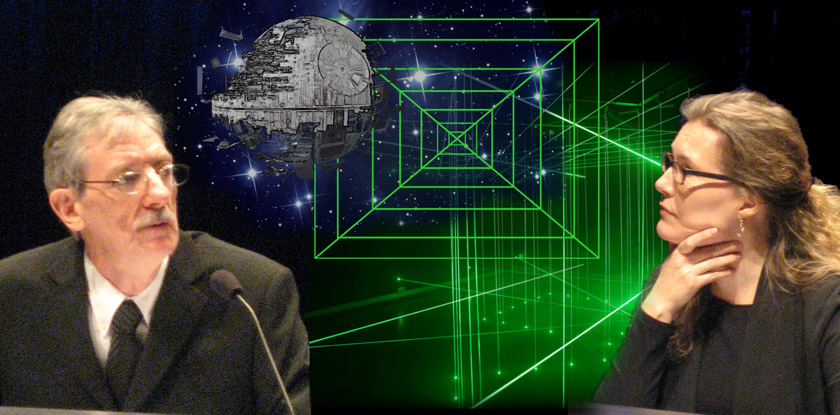
In a similar same vein on the 15th January 2016 Anasol Carmina Peña Rios gained a PhD from Essex University entitled ‘Exploring Mixed Reality in Distributed Collaborative Learning‘ in which the research vision was motivated by a Science-Fiction Prototype (SFP) called “Tales from a pod” which took a speculative look at how artificial intelligence and mixed-reality technology might be combined to change the nature of education by the year 2048. The outcome of this research was prototype mixed reality science lab called, BReal which was successfully tested with collaborative teams of dispersed learners drawn from students based in Essex University (UK), Anglia Ruskin University (UK), Leon Institute of Technology (Mexico), San Diego State University (USA), Shijiazhuang University (China), Shanghai Open University (China), Khalifa University of Science, Technology and Research (UAE) and Monash University (Malaysia). Preliminary results showed real benefits for distance learners and beckoning changes in the very nature of higher education. For more information click on this link.
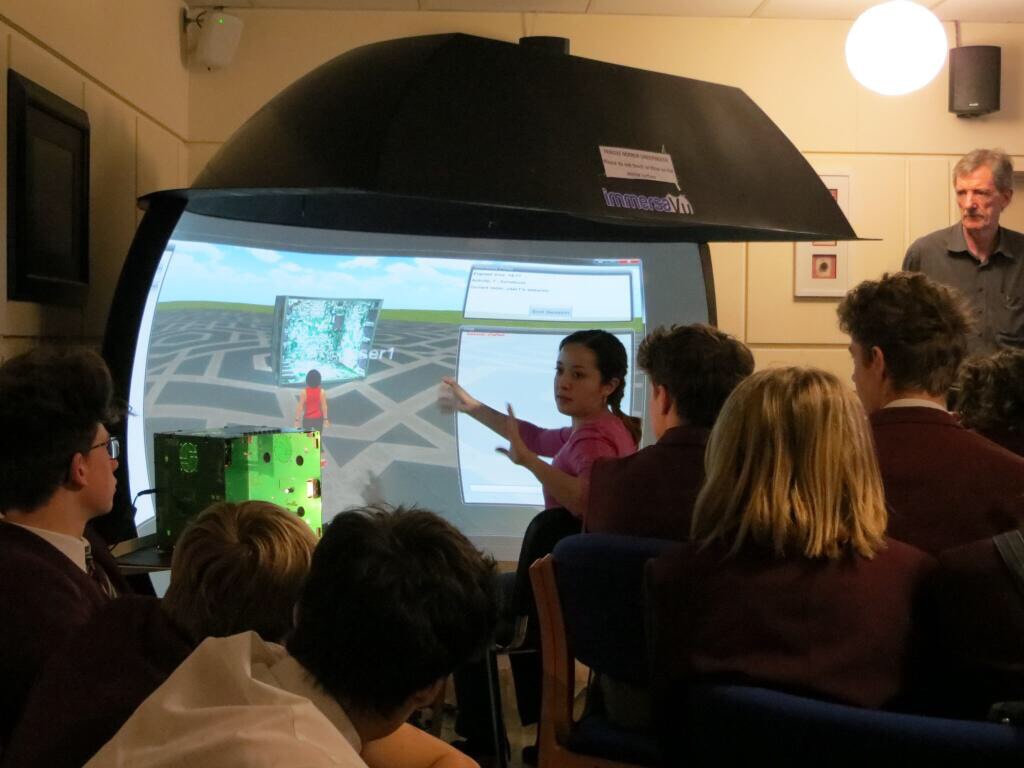
Another significant milestone was reach on the 1st February 2016 when Shumei Zhang published a book that showed how Science Fiction Prototyping can be used for teaching students language. Science fiction prototyping has proven to be an excellent vehicle for exercising language and motivating student’s interest in science. The book, “Computer English Teaching Using a Creative Science Approach” is published by Tsinghua University Press and is aimed at teaching English, Creativity and Computing to Chinese science and engineering university students.
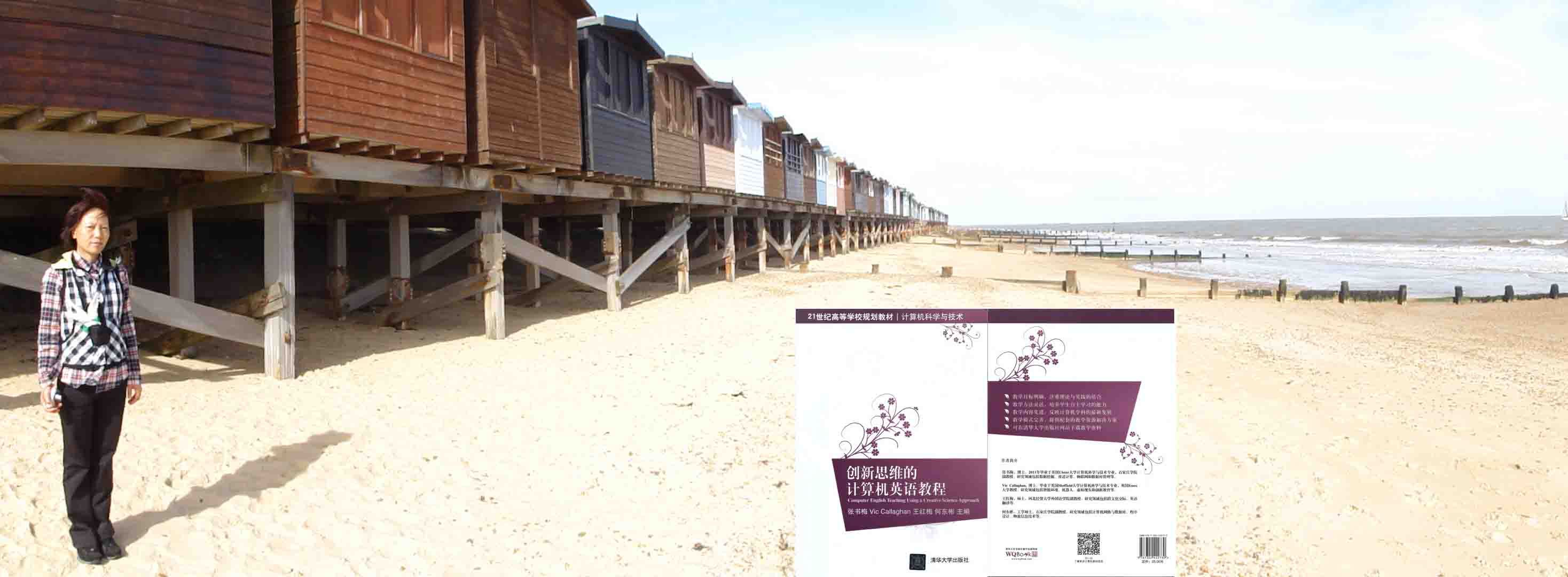
Of course, however it started, the Creative Science Foundation would be nothing without its members. To build it into a functioning movement required more than weißbier! In fact it took a lot of hard work by a large number of people. At the time of this revision (May 2015) the following lists events marking the development of Science Fiction Prototyping and The Creative-Science Foundation.
- Ulm (Germany) Encounter, 25th September 2007 at IE’07 (the moment that the founding SFP ideas and parties came together).
- Seattle (USA) Meeting, 22nd July 2008 at IE’08 (paper by Simon Egerton, Graham Clarke & Vic Callaghan describing multiple personas and irrational thinking for robots inspired Brian Johnson to write the ‘Nebulous Mechanisms’ SFP which eventually became Intel’s 21st Century Robot project; this meeting also formulated a roll-out plan for SF-Prototyping).
- Barcelona (Spain) Performance, 20th July 2009 (first public reading of a SF-Prototype,’Nebulous mechanisms’; first public lecture on ‘SF-Prototyping’ in form of keynote from Brian Johnson; this gathering also proposed the G&T ‘Free-Will’ test).
- Kuala Lumpur (Malaysia) Workshop, 19th July 2010 (this was the first Creative-Science workshop which was organised by Brian Johnson, Simon Egerton and Vic Callaghan).
- Nottingham (UK) Workshop, 25-26 July 2011 (this was the 2nd, and largest, Creative Science workshop to date and hosted the filming of short documentary describing Creative Science. The event was organised by Brian Johnson, Simon Egerton and Vic Callaghan).
- Creative Science Foundation formed (with an international remit but for legal purposes, is based out of London UK), 4th November 2011
- Washington Undergraduate Computer Security Module, spring of 2012 (this was the first main-stream undergraduate science and engineering university course to use SFP. It was organised by Tadayoshi Kohno as part of an optional senior level course for Computer Science and Computer Engineering students at the University of Washington) as an aid to students developing broader contextual thinking around computer security).
- Taipei (Taiwan) Workshop, spring of 2012 (this was the first usage of SF-Prototyping to teach non-science students. It was organised by Hsuan-Yi Wu in the form of an Imagination Workshop for 45 National Taiwan University e-Commerce students).
- Futures Journal, June 2013 (This was the first special issue of a journal focusing on SF-Prototyping. It adopted the theme ‘Exploring Future Business Visions Using Creative Fictional Prototypes’ and was organised by Gary Graham, Anita Greenhill, and Vic Callaghan).
- Outer Limits, 16th of July 2013 ( (This was the fist SF-Prototyping ‘Bolt-On’ event organised by Jeannette Chin and Vic Callaghan as part of the 1st “Cloud of Things” workshop in Athens, Greece).
- IEEE Computer Column about SFP, starting with Jan. 2013 (this was the first column about SF-Prototyping to appear in a main stream publication – the columns were written by Brian David Johnson; the first column, in Issue No.1 Vol.46, was called ‘When Science Fiction and Science Fact Meet’).
- British Academy of Management, 6th February 2013 (this London based workshop was remarkable in that it took SF-Protecting to a new audience, of mature business professionals based on the theme ‘Strategic Visions and Future Business Models: Exploring Future Technology, Smartness, Creative Science Prototyping and Consumer Technological Landscapes).
- USA Academy of Management, 10th August 2013 (this Florida based workshop brought the ideas of SF-Prototyping to an American business audience using the theme “Exploring Future Technology/Innovation Through Creative Science Prototyping”).
- Creative Science 2013 Workshop, 29th November 2013 (this workshop is notable in that it featured an education theme; ‘Exploring the Future of Education’ as part of the Immersive Education Forum).
- San-Diego (USA) Study, Fall 2013-Spring 2014 (this was the first academic study of SF-Prototyping producing a report entitled ‘Using Science Fiction Prototyping to Decrease the Decline of STEM’ completed by Lloyd Austin, Lizbeth A. Cazarez, Mary de Lepe and Connor Russel and supervised by Prof Minjuan Wang).
- Technological Forecasting and Social Change Journal, May 2014 (this was the second special issue of a journal focusing on SF-Prototyping with the theme ‘ Creative Prototyping’ organised by Gary Graham, Anita Greenhill, and Vic Callaghan).
- Colchester (UK) New Creatives, Fall 2014 (this was the first SF-Prototyping event organised for k12 pre-university students by Anasol Pena-Rios & Vic Callaghan with the hope of motivating more students in to STEM careers. It was also notable in that it was the first use of Twitter sized micro-SFPs introduced by Anasol Pena-Rios).
- Shanghai Workshops, China, 1st July 2014 (this marked the first SFP ‘cluster event’ that included a SFP workshop, micro-SFP competition, film and keynote all of which was organised by Hsuan-Yi Wu, Anasol Pena-Rios, Simon Egerton, Brian Johnson & Vic Callaghan
- Helsinki (Finland), Aalto ARTS PhD, 4th February 2015 (this was the first PhD in Science Fiction Prototyping entitled “Science Fiction Prototypes as Design Outcomes of Research” which was completed, with distinction, by Dr. Tiina Kymäläinen).
- Future City Innovation Workshop, 21st Jan 2015, (This event marked a collaboration between the ‘Future City and Community Resilience Network’ and the ‘Creative Science Foundation’ to explore how SF-Prototyping can be used to harness an SFP driven innovation approach to the design ‘Future Cities’ . The event was a collaboration between Gary Graham and Hsuan-Yi Wu).
- The Tomorrow Project, August 2011 (this was an Intel funded venture led by Brian David Johnson, to explore the use of professional SF authors for extrapolating science fact)
- The 21st Century Robot (Portland, USA) September20, 2013 (this is a collaboration between Intel, Maker Media and Trossen Robotics to create a crowd sourced open-innovation project to investigate the nature of future domestic robots. The project is built around the SFP story ‘Nebulous Mechanisms: The Dr Simon Egerton Stories’, a robotics platform and 3D printable skins).
- CCCU Undergraduate Entrepreneurship Module, Fall 2014 (this was the first application of SFP to teaching entrepreneurship that was organized by Ping Zheng as part of the BSc/BA Programmes at Canterbury Christchurh University, Business School course on Entrepreneurship, and took the theme ‘Creativity, Ideas and Innovation’).
- iDesk SFP Realisation, October 2012-September 2015 (This was an ambitious PhD project undertaken by Anasol Pena-Rios, aimed at implementing the “Tales From a Pod” Science Fiction Prototype that was originally presented at CS’10. To date she has built the technological platform and conducted successful evaluations with remote sites in China, Korea, Mexico and the USA).
- Shijiazhuang (China) Computer English, 2013-2015 (Every Chinese science and engineering student is required to study English! This project, organised by Shumei Zhang, in cooperation with in collaboration with Tsinghua University Press, and other colleagues is exploring the application of SF-Prototyping to teaching a combination of computer science and English language).
….and Finally
Of course we are not alone in wondering about the futures. So, we thought we would close this note by sharing with you some of the books we have enjoyed that reflect on futures past and to come, in the hope you will find them interesting.
Some Interesting Books (reflecting on futures past and to come).
- Isaac Asimov “Where Do We Go From Here“, Doubleday, 1971, ISBN 0385029357
- Gregory Benford “The Wonderful Future That Never Was“, Hearst Books (Sterling Publishing), 2010, ISBN 978-1-58816-822-1
- Gregory Benford “The Amazing Weapons That Never Were“, Hearst Books (Sterling Publishing), 2012, ISBN 978-1-58816-862-7
- Adrian Berry “The Next Ten Thousand Years: A Vicion Of Man’s Future In The Universe“, Thirty Bedford Square (E P Dutton), 1974, ISBN 0-224-00966-4
- Rodney A Brooks “ROBOT: The Future of Flesh and Machines“, Penguin Press, 2002, ISBN 0-713-995-017
- Norman Brosterman “Out Of Time: Designs For The Twentieth-Century Future“, Harry N. Abrams, Inc., 2010, ISBN 0-8109-2939-2
- Joseph J Corn “Imagining Tomorrow: History, Technology, and the American Future“, 1987, ISBN 0-262-03115-9
- Joseph J Corn “Yesterday’s Tomorrows; Past Visions Of The American Future“, The John Hopkins University Press, 1984, ISBN 0-8018-5399-0
- Anthony Dunne “Hertzian Tales“, RCA-CRO Publications, 1999, ISBN 1-874175-27-6
- Eric Drengi & Jonathan Dregni “Follies of Science: 20th Century Visions of Our Fantastic Future“, Spec Press, 2006, ISBN 1-933108-09-6
- K. Eric Drexler “Engines of Creation“, Oxford University Press, 1990, ISBN 0-19-286149-2
- George Dyson “Darwin Among The Machines“, Penguin Books, 1997, ISBN 0-140-26744-1
- David D Friedman “Future Imperfect; Technology And Freedom In An Uncertain World“, Cambridge University Press, 2008, ISBN 978-0-521-87732-9
- Bill Gaver “The Curious Home“, Goldsmiths, 2007, ISBN 978-1-904158-81-3
- Hugo Gernsback “Ralph 124C 41+; A Romance of the Year 2660“, Bison Books (reprint), 2000, ISBN 0-8032-7098-4
- Jane Goldman “The X-Files: Book Of The Unexplained“, Simon & Schuster, 1995, ISBN 0-684-81633-4
- Gribbin, Fernandez-Armesto, Heisbourg, Lewis. Gearty,, Thomas, Grayling, Winston, Ridley, Barwise/Hammond “The future Now; Predicting the 21st Century“, Weidenfeld & Nicolson, 1998, ISBN 0-297-84271-4
- Sian Griffiths “Predictions“, Oxford University Press, 1999, ISBN 0-19-286210-3
- Yuval Noah Harari “Sapiens; A Brief History Of Humankind“, Harvill Secker, 2014, ISBN 978-1-846-55823-8
- Geoffrey Hoyle “2011; Living The Future“, Green Tiger Press, 2010, ISBN 978-1-59583-430-0
- Tim Jones & Caroline Dewing, “Future Agenda: The World in 2020“, Infinite Ideas, 2010, ISBN 978-1-9066821-57-9
- Herman Kahn & Anthony J Wiener “The Year 2000: A Framework For Speculation on The Next Thirty-Three Years“, Collier-Macmillan, 1967, ISBN 0025604406
- Herman Kahn “The Next 200 Years“, Associated Business Programmes Ltd, 1976, ISBN 085227-0721
- Michio Kaku “Visions: How Science Will Revolutionize The 21st Century And Beyond“, Oxford University Press, 1998, ISBN 0-19-850086-6
- Ray Kurzweil “The Age of Spiritual Machines (When Computers Exceed Human Intelligence)“, Viking -Penguin Press, 1999, ISBN 0-670-88217-8
- Ray Kurzweil “The Singularity Is Near“, Duckworth Overlook, 2005, ISBN 978-0715635612
- Bruno Latour “ARAMIS Or The Love Of Technology“, Harvard University Press, 1996, ISBN 0-674-04322-7
- Alfredo Marcantonio “Prophets of Zoom“, Merrell, 2007, ISBN 978-1-8589-4401-2
- Marvin Minsky “The Society of Mind“, Touchstone Book (Simon & Schuster), 1985, ISBN 0–671-65713-5
- Archibald Montgomery Low “It’s Bound To Happen“, The Burke Publishing Co Ltd (with The Scientific Book Club), 1950, ASIN: B0017PGBB4
- Hans Moravec “ROBOT: Mere Machine to Transcendent Mind“, Oxford University Press, 1999, ISBN 0-19-511630-5
- Chris Morgan “The Shape Of Futures Past: The Story Of Prediction“, Web & Bower (Publishers) Limited, 1980, ISBN 0-906671-15-9
- Stephen Rosen “Future Facts”, Heinemann, 1976, ISBN 0-434-64959-7
- Liam Ryam “Dammit Science, Where’s My Hoverboard?“, Hardie Grant Books, 2013, ISBN 978-174270655-9
- Bob Seidensticker “Future Hype; The Myths Of Technology Change“, Berrett-Koehler Publishers Inc, 2006, ISBN 978-1-57675-370-0
- William Shatner & Chip Walter “Star Trek: I’m Working On That (A Trek From Science Fiction to Science Fact)“, Pocket Books, 2002, ISBN 0-671-04737-X
- Tom Standage “The Future of Technology“, Profile Books Ltd (with the Economist), 2005, ISBN 1-86197-971-1
- Mark Stevenson “An Optimist’s Tour Of The Future“, Profile Books, 2011, ISBN 978-1-84668-357-2
- Sir George Thomson “The Foreseeable Future“, Cambridge University Press, 1955, ISBN 0670015083
- Sean Topham “Where’s My Space Age: The Rise And Fall Of Futuristic Design“, Prestel-Verlag, 2003, ISBN 3-7913-2844-1
- Richard Watson “50 Ideas You Really Need To Know The Future“, Quercus Editions Ltd, 2012, ISBN 978-1-78087-159-2
- Richard Watson “Future Files: A Brief History Of The Next 50 Years“, Nicholas Brealey Publishing, 2008, ISBN 978-1-85788-534-7
- Sam Williams “Arguing AI: The Battle For Twenty-First-Century Science“, AtRandom.com Books, 2002, ISBN 0-8129-9180-X
If you are aware of related books that we might add this this list please let us know by clicking this link.
